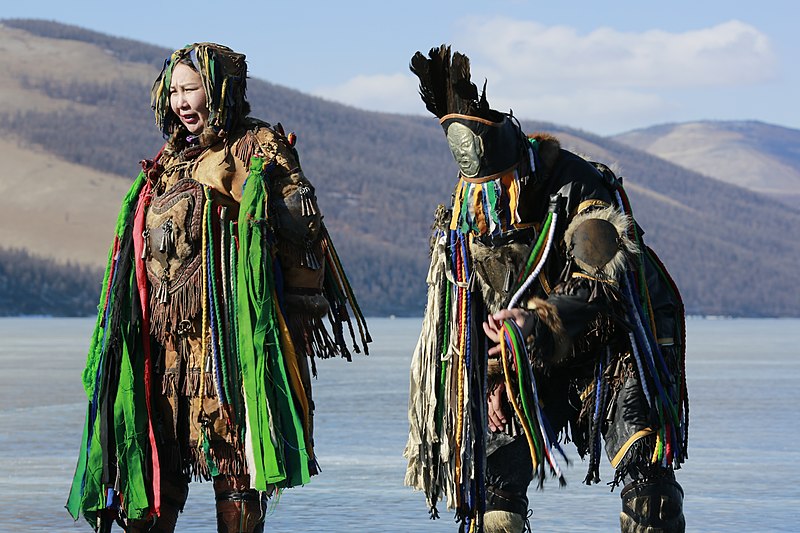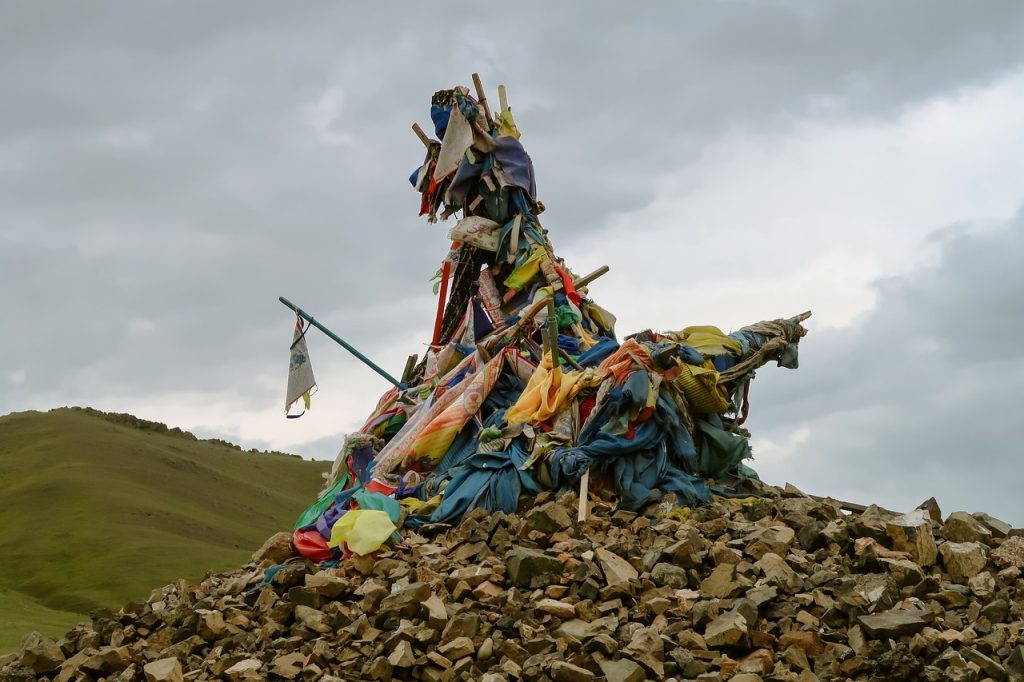Blog
Tengriism: The Ancient Religion of Mongolia
We’re all familiar with globally recognized religions such as Christianity, Islam, and Buddhism. But have you ever heard of Tengriism? This term might sound unfamiliar, but it carries a rich history and cultural significance, particularly for the nomadic people of Central Asia.
Tengriism, shrouded in the mists of ancient folklore, carries a unique charm. Its distinct features and spiritual beliefs, while lesser-known, can rival the complexity and depth of other major religions. Today, let us set sail on a voyage to unearth and explore the mystical world of Tengriism.
The Rooted Belief in Sky Deity: Tengri

Tengriism, at its heart, revolves around the worship of Tengri – the Sky God. This emphasis on the sky as a divine entity might seem peculiar to some. However, for the nomadic Mongols, the sky is a constant companion. Its ever-present expanse accompanies their every journey, just like a guide from the heavens above.
Consider how your friends or family are integral to your life. In the same way, for the nomadic Mongols, Tengri has been an inseparable part of their existence, providing them with strength, guidance, and assurance as they navigate the vast terrains of Mongolia.
The Pantheon of Tengriism: Yer-Sub and Erlik
While Tengri holds a central place in Tengriism, the religion is polytheistic, recognizing several other gods.
Yer-Sub: The Goddess of Earth
Yer-sub, the goddess of the earth, is another important deity in Tengriism. If Tengri symbolizes the endless sky, Yer-sub represents the nurturing earth. Picture the earth as a generous mother, providing sustenance and life to her children. That’s Yer-sub for the followers of Tengriism, a symbol of abundance, fertility, and life itself.
Yer-sub’s importance is not just due to her nurturing qualities, but also for her embodiment of resilience and endurance. These traits mirror the Mongolian nomads, who, much like the earth, are resilient, surviving, and thriving amidst the challenging landscapes and harsh climates of Mongolia.
Erlik: The God of the Underworld
Beyond the sky and the earth, Tengriism also acknowledges Erlik, the god of the underworld. Consider Erlik as a gatekeeper, managing the realm of the deceased. Despite his association with death and the underworld, Erlik is not a figure of fear but one of respect.
Erlik’s role is crucial in the life-death-rebirth cycle believed in Tengriism. He oversees the transition of spirits, ensuring the cycle of life continues smoothly. This aspect of Tengriism shows a profound understanding of life’s cyclical nature, recognizing the inevitability of death, and the potential for new life thereafter.
Tengriism’s Profound Influence on Mongolian Culture
Tengriism is not just a religion but a cornerstone of Mongolian culture. Its profound influence echoes through the passage of time, shaping traditions, beliefs, and societal norms. It’s as deeply embedded in Mongolia’s cultural fabric as, say, the influence of the Grand Canyon on America’s national identity.
In Mongolia, Tengriism’s imprint is omnipresent, from the folklore sung around the fire to the spiritual rites performed at sacred ceremonies. This pervasive impact is a testament to the enduring power and relevance of this ancient religion.
Tengriism and Shamanism: A Blend of Spiritual Practices
The ties between Tengriism and shamanism run deep, akin to two old friends sharing secrets and stories. Shamanism, with its unique spiritual practices and rituals, complements and enriches Tengriism.
Shamans act as spiritual intermediaries, linking the earthly realm with the divine. They perform rituals, interpret omens, and communicate with spirits, bridging the gap between humans and their gods. In the great narrative of Tengriism, shamans are the protagonists, leading the spiritual journey and guiding their community towards divine wisdom.
The Spiritual Rituals and Practices in Tengriism
Rituals and practices form the pulsating heart of Tengriism. They are the melodies and rhythms that breathe life into this ancient religion.
Prayer and Sacrifice
Prayer and sacrifice are key practices within Tengriism. Through these acts, followers express their devotion and reverence, forging a spiritual connection with the divine. It’s akin to sending a heartfelt message, pouring your thoughts and emotions into words, hoping for a response from the other end.
Sacrifices, often made to gods and spirits, serve a dual purpose. Firstly, they signify respect and gratitude towards the deities. Secondly, they symbolize a physical surrender of something valuable, signifying a spiritual commitment.
Nature Veneration

Tengriists believe in the sacredness of nature. They see the divine not only in celestial beings but also in the mountains, rivers, and forests surrounding them. Appreciating nature for Tengriists is not just a hobby but a form of worship. You will see creepy teepees everywhere in Mongolia.
This respect towards nature is ingrained in their daily lives. They hunt and gather without exploiting resources, understanding that the earth nourishes them and deserves their respect in return. It is this harmonious balance with nature that makes Tengriism so captivating.
The Enduring Legacy of Tengriism
Tengriism, though not as globally recognized as some other religions, stands tall like an ancient tree, weathering time and change. Its roots, deeply embedded in the Mongolian landscape, continue to nurture its cultural identity.
It’s not just a remnant of the past but a living tradition, influencing contemporary Mongolian lifestyle, arts, and values. Like a timeless melody, it continues to resonate, echoing its profound wisdom to those willing to listen.
Final Thoughts
Tengriism, far from being a forgotten relic of the past, is a vibrant and complex spiritual tradition. With the sky god Tengri at its heart, it embraces a multitude of gods and spirits, each playing their part in the grand orchestra of divinity.
The ancient religion, intertwined with nature and shamanism, continues to influence Mongolian culture and identity. It’s a testament to the enduring power of faith, showing us that even the oldest melodies can continue to enchant us if we take a moment to listen.
Frequently Asked Questions
What do Tengriism belive in?
Followers of Tengriism believe in a pantheon of deities with Tengri, the Sky God, as the chief deity. They view the universe as a creation of Tengri and revere Yer-sub, the earth goddess, and Erlik, the god of the underworld. They also adhere to shamanistic practices, venerate nature, and believe in a life-death-rebirth cycle.
Who are the gods of Tengriism?
The chief deity in Tengriism is Tengri, the Sky God. Other significant deities include Yer-sub, the goddess of the earth, and Erlik, the god of the underworld. There are also various nature spirits and lesser deities that are worshipped.
Is Tengriism still practiced?
Yes, Tengriism is still practiced, particularly in Mongolia and among several Turkic and Siberian communities. Although not as widespread as it once was, it continues to influence Mongolian culture, traditions, and lifestyle.
What type of religion is Tengriism?
Tengriism is an ancient, polytheistic, and shamanistic religion. It is a spiritual tradition primarily associated with the nomadic peoples of Central Asia, particularly Mongolia.
How old is Tengriism?
Tengriism is an ancient religion that predates the Common Era. It is believed to have been practiced since at least the 6th century BCE, making it over 2500 years old.
How is Tengriism different from Islam?
Tengriism and Islam have distinct differences. Tengriism is a polytheistic and shamanistic religion with a strong connection to nature and ancestor veneration, whereas Islam is monotheistic, believing in one God, Allah, and follows the teachings of the Prophet Muhammad as outlined in the Quran. Additionally, the rituals, practices, and traditions in both religions are distinctively different.
Did Genghis Khan worship Tengriism?
Historical accounts suggest that Genghis Khan followed Tengriism, attributing his success in battles to the grace of Tengri, the Sky God. However, he was known for his religious tolerance and adopted practices from various religions.
